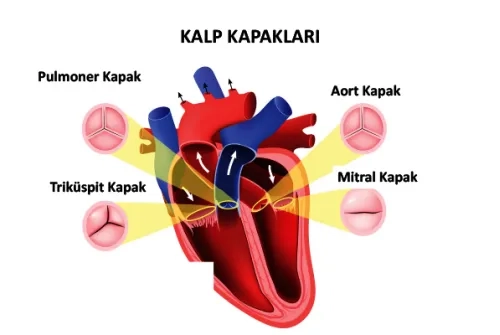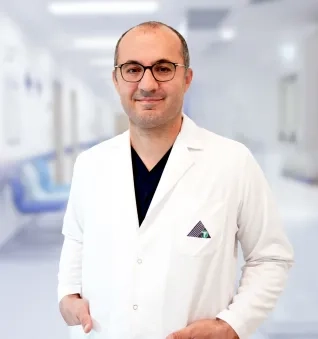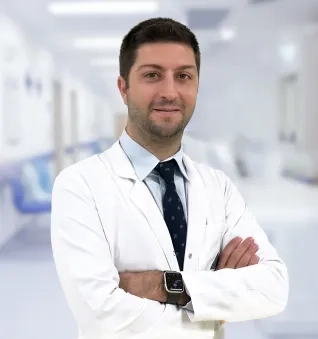Alo Yeditepe
Alo Yeditepe
Heart Valve Diseases and Treatment Methods
How Does a Healthy Human Heart Work?
The main function of our heart is to pump oxygen-rich clean blood to other organs and tissues of the body through the arteries, and to take dirty blood whose oxygen content has been depleted by the tissues through the veins and send it to the lungs for purification. Directing the blood in the right direction within this circulation and pumping it in sufficient quantities is ensured by our heart valves. The valves open like a leaf as blood is pumped forward, and when the heart relaxes and the contraction ends, they close to prevent blood from flowing back. The proper functioning of the valves ensures that the heart, which works in a certain order, rhythm and order, can provide blood flow in the correct direction and amount.
Which Valves Do What Function?
We have four valves:
Aortic, Pulmonary, Mitral and Tricuspid valves.
Among these valves, the aortic valve is located between the left ventricle and the aorta, which sends clean blood to the aorta, our main artery, and from there to all tissues. Pulmonary valve is between the pulmonary artery and the right ventricle, Mitral valve is between the left atrium and ventricle, and Tricuspid valve is between the right atrium and right ventricle. The blood flow in and out of the heart is under the control of all these valves.
What is Heart Valve Disease?
Heart valve disease refers to any of several conditions that prevent one or more valves in your heart from working properly.

What are the Types of Heart Valve Disease?
There are basically two types: Valve stenosis and Valve insufficiency.
Valve Stenosis
Valve stenosis causes the tissues that form the valve leaflets to harden, narrowing the valve opening and reducing the amount of blood that can flow through it. Mild narrowing may not reduce the overall functioning of your heart. But the valve can become so narrow (stenosis) that it reduces your heart's function, making it harder for your heart to pump and straining it. As a result, the rest of your body may not receive adequate blood flow.
Valve Insufficiency
It is also referred to as a leaky cap. When the valves do not close completely, blood leaks backwards through the valve. Blood leaking backwards can cause improper enlargement of the heart, failure to send sufficient blood to the tissues, and heart failure.
What are the Causes of Heart Valve Diseases?
The most common cause in developing countries is still rheumatic fever, which develops after poorly treated throat infections (due to streptococcus bacteria). Heart infections (infective endocarditis), congenital valve abnormalities, heart attacks, heart failure, aneurysms, some auto-immune and rheumatic diseases, and aging can cause heart valve diseases.
What are the Symptoms of Heart Valve Diseases?
Those with heart valve disease may have no complaints at first or the symptoms may be very faint. As time progresses, complaints and symptoms become more evident; shortness of breath, palpitations, chest pain, dizziness, fainting or feeling faint, fatigue, and in very advanced cases, edema in the ankles, feet or abdomen may occur. If the valve problem is due to heart infection, fever may occur.
Which Tests Are Used in Heart Valve Diseases?
First of all, the physical examination of the referred physician is of great importance. In some valve diseases, murmurs (abnormal heart sounds) or abnormal sounds heard during heart examination are the most helpful in reaching the correct diagnosis. After the examination, diagnostic tests include blood tests, chest x-ray, electrocardiography, echocardiography, cardiac MRI and, when necessary, angiography and cardiac catheterization.
What Happens When Heart Valve Diseases Are Untreated?
If the valve disease progresses and is not treated; It can cause heart failure, stroke and sudden death.
How to Treat Heart Valve Diseases?
Heart valve disease treatments depend on the underlying cause. Treatment is planned according to the degree of valve involvement. Treatment options include only follow-up, follow-up with medication, repair or renewal of a dysfunctional valve with surgery, or non-surgical interventional closed methods (catheter-based).
Are there any non-surgical treatment methods for valve diseases other than the aortic valve? Mitra-Clip for mitral valve insufficiency, balloon valvuloplasty for mitral and pulmonary valve stenosis, and Tri-clip (latching) methods applied in severe tricuspid valve insufficiency in recent years can be applied as non-surgical catheter-based interventional treatment methods.
What should patients with valve disease pay attention to?
Patients with valve disease should go to their doctor for regular check-ups, take their prescribed medications regularly, eat healthy (Mediterranean type diet or the type of nutrition recommended specifically for the patient), avoid smoking, exercise regularly (or engage in physical activity), and maintain oral hygiene that poses a serious risk for heart infection. They should pay attention.
This content was prepared by Yeditepe University Hospitals Medical Editorial Board.
”
See Also
- What is Heart Rhythm Disorder (Arrhythmia)? Symptoms and Causes
- How Do We Know When We Have a Heart Attack?
- What is Sudden Cardiac Death? What are the Symptoms?
- Risk Factors in Heart Diseases
- How Do Heart Disease Risk Factors Affect Women and Men?
- What is a Heart Attack? What are the Symptoms of a Heart Attack?
- What is Broken Heart Syndrome? Symptoms and Treatment
- Carotid Artery Disease
- What is Renal Denervation?
- What is Intravenous Ultrasound (IVUS)?
- Renal Denervation in Hypertension Treatment
- What is TAVI?
- Is Your Heart Ready For Winter?
- The Risk of High Blood Pressure Increases as You Go to High Altitudes
- By 2025, Hypertension Patients Are Expected to Reach 1.5 Billion
- Misconceptions about the Female Heart
- Blood Pressure Holter
- Coronary CT Angiography (Virtual Angiography)
- Effort Test
- Heart Attack Causes and Symptoms
Alo Yeditepe








